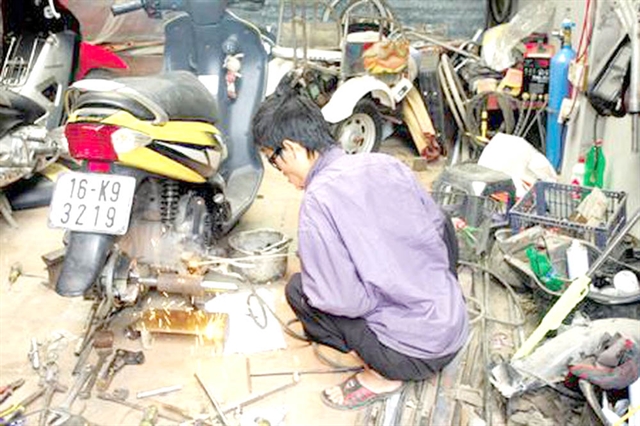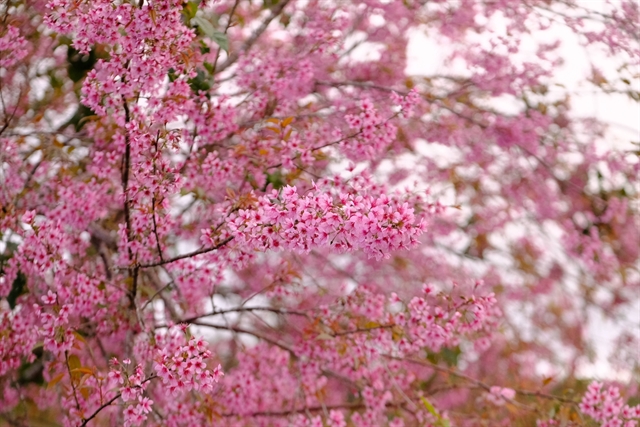 Features
Features

Diêm Trọng Thách from the northern province of Bắc Ninh has proved that the persistent pain and hardship that come with suffering from AO can never defeat him.

|
| MAKING A DIFFERENCE: Diêm Trọng Thách (right) has set a good example for other Agent Orange / dioxin victims by overcoming hardship and pain to move forward. Photo dangcongsan.vn |
Diêm Trọng Thách from the northern province of Bắc Ninh would be a regular person were it not for the fact that five of the seven members of his family, including Thách and his four children, were Agent Orange (AO) victims.
Not that this defines him, as he’s well-known in the provincial capital of Bắc Ninh City’s Võ Cường Ward as a strong-minded individual with an extraordinary intellect and energy.
The war veteran and his family own a small business -- a motorbike garage also used as a mechanical workshop for turning two-wheelers into three-wheelers for those with disabilities.
The workshop provides a stable source of income not only to Thách and his family but also his dozens of employees, many of whom are also facing difficult circumstances.
Thách has proved that the persistent pain and hardship that come with suffering from the deadly defoliant chemical that US military forces sprayed in Việt Nam can never defeat him.
In 1972, Việt Nam had entered into the fiercest time of its resistance war against the Americans. Like many other young people, Thách joined the army, working as an engineer with Division 338 at the famous battlefield of Khe Sanh in the central province of Quảng Trị.
After the country was liberated in 1975, he was more fortunate than many, returning home and reuniting with his family. A year later, in 1976, he was married and he and his wife went on to have four sons.
But the war was not done with him, as all four were born with side effects from the toxic chemical. They all suffered from muscular atrophy and paralysis by the age of five.
The couple were shocked and then saddened and concerned. At the time, it seemed the children were suffering from some unknown but cruel disease. Their dream of a happy, large family suffered too.
His wife, Nguyễn Thị Ý, said that every time she saw one of her children stumble and be unable to get up, all she could do was pick him up, hug him, and cry. With the hope of finding a cure, they borrowed money from relatives and took the boys to a number of hospitals in different places but a cure could not be found.
They kept their hopes up, though, until they took them to the Hà Nội Paediatric Hospital in the capital and the Ba Vì Orthopaedic Centre on the outskirts of the city, where doctors concluded the children were all suffering from the effects of AO/dioxin passed down from their father and there was no known cure.
It was shattering news. Thách and his wife cried tears of sadness for long periods of time, not knowing if they could survive. They finally decided to suppress their pain and accept the reality.
Though walking remains difficult for all four, mentally they are fine, which is of major consolation to their parents.
Although Thách's health is also not good and his wife’s is even worse, having fought off a bout of cancer, they have never been pessimistic, instead doing whatever was needed to support their boys.
First, they tried to work harder and longer in the fields, growing rice and vegetables for sale at the local market. “But we always wondered,” Thách remembered, “if we were to fall ill, who would take care of our children?”
As they grew up, the four boys came to understand that their parents were poor and so never complained or made demands, instead learning to do what they could to help ease the burden.
“The kids dreamt of having a computer, but it was simply impossible,” Thách said. “Fortunately, though, the Ministry of Labour, Invalids and Social Affairs gave us one, which was a dream come true for the boys. Now they can learn what they can about the outside world.”
His wish, however, was always to find a way to help his children become mobile and able to travel around, so he decided to embark upon creating a special vehicle.
He gave a lot of thought to what he could do with motorbikes -- the most popular means of transport around the country but not easy for the disabled to drive.
“I decided to convert an old two-wheeler into three-wheeled motorbike after studying the mechanics and the frame,” Thách said.
He tested his first creation carefully and cautiously. Though able-bodied, he noted issues a disabled driver was likely to encounter as he drove long distances, even as far as the mountainous province of Lạng Sơn.
After nearly a year of experimentation, Thách decided his three-wheeler was as safe as could be and was easy for people with a disability to get around on.

|
| SHARED EFFORT: One of Thách’s sons, who is also an AO victim, helps him convert two-wheelers into three-wheelers. Photo giadinh.net.vn |
His children posted information online about how he converted two-wheelers into three-wheelers and received a lot of positive feedback.
Enquiries about buying one were such that he felt encouraged to open a workshop for him and his family to create three-wheeled motorbikes for the disabled.
The early days were tough, but each and every incarnation was better than the one before and there was a steady flow of customers. From his simple, initial purpose of doing something useful, Thách and his children have now not only helped so many others in a similar situation but also made their own lives better.
And so much more. “This has given us a great deal of happiness,” Thách said.
The mobility a three-wheeled bike provides gives the disabled some much-needed confidence and hope of a better life, he realised.
More and more customers, from the north to the south of Việt Nam, have ordered one of his bikes.
He’s converted more than 200 since 2007, and also makes electric three-wheelers.
As the goal is to help those in need, Thách sells his bikes at the most reasonable price possible.
“We only want to earn about VNĐ1 million (US$45) in profit on each bike,” he explained. “Every month we sell four or five.”
In 2018, with support from Bắc Ninh provincial authorities and a number of donors, Thách’s family built a house. Their joy doubled soon after, when their fourth son was married and a healthy baby boy was born after the couple underwent artificial insemination.
As for the future, the family need more investment to expand the workshop and make more three-wheelers for their growing list of customers.
“This makes our lives so happy and rewarding, and it’s a viable livelihood,” according to Thách.
“Looking back, there was a time we all felt hopeless and could only curse our fate instead of looking to the future,” he said. “Now, as grandparents, we see that to be alive means continuing to have aspirations. The pain I feel is no longer so painful.”

|
| TURNING POINT: A three-wheeler makes life so much easier for people with disabilities. Photo giadinh.net.vn |
“A strong will and energy, with help from the community, helps alleviates the pain AO victims suffer,” Thách believes.
According to Nguyễn Văn Nhân, chairman of the Association of Agent Orange/Dioxin Victims in Bắc Ninh, Thách and his family are active members of the organisation.
“They are not only a good example for AO victims in the province but also help promote emulation activities we organise,” he said. “They have triumphed over the pain of AO, and improved their lives.”
Speaking at a recent international workshop in Hà Nội to evaluate the impact of AO/dioxin in Việt Nam, Deputy Prime Minister Vũ Đức Đam said the State, the Government, and the people all hoped that the victims of war, especially AO/dioxin victims, would receive sufficient support.
“Việt Nam has done a great deal to assist victims while calling upon the international community, countries, organisations, and individuals at home and abroad to help overcome the consequences of the toxic chemicals sprayed by the US military forces during the war,” he added.
The US military forces sprayed about 80 million litres of toxic chemicals, mainly AO/dioxin, over the south of Việt Nam from 1961-1971. Nearly 4.8 million Vietnamese people were exposed to the chemicals and about 3 million people and their descendants suffer from health problems as a consequence of that exposure. VNS




